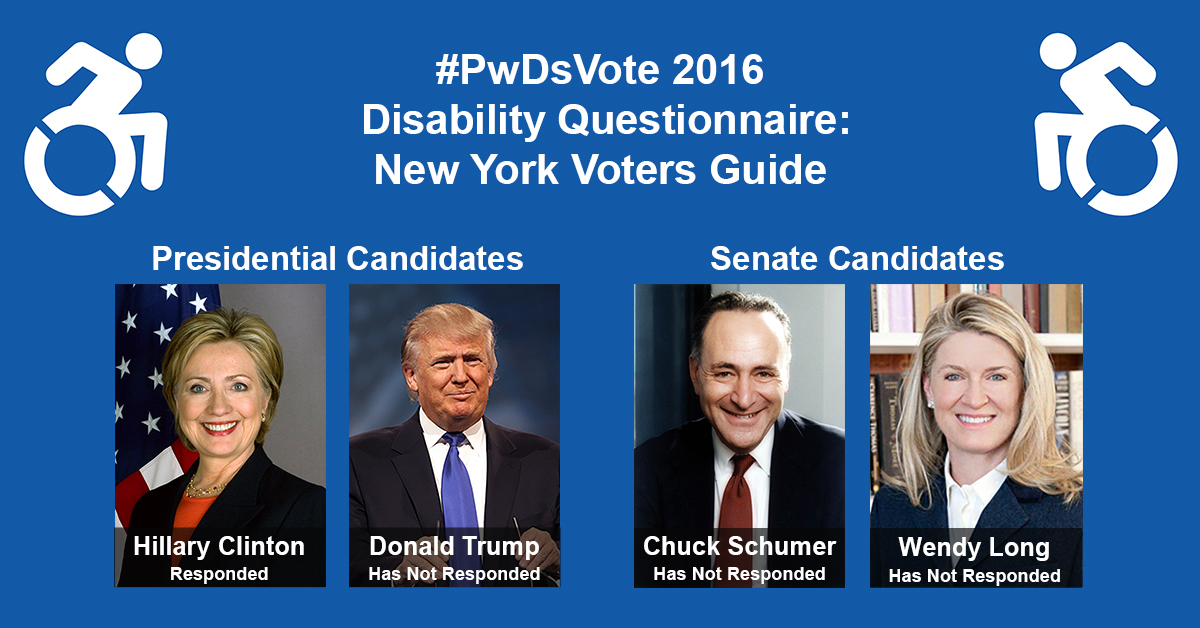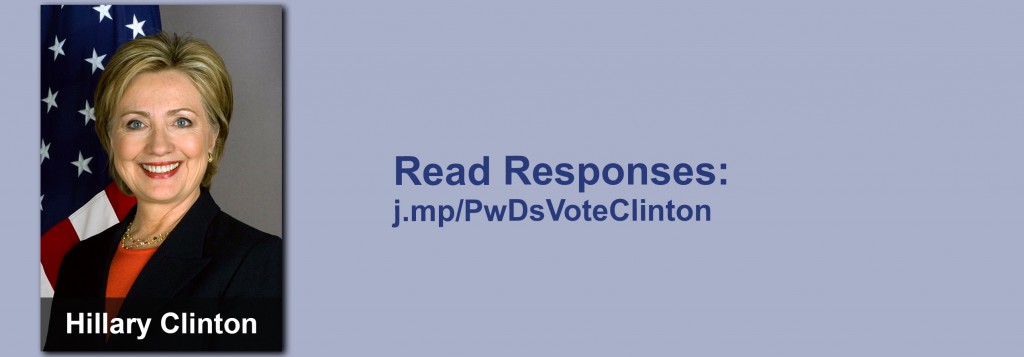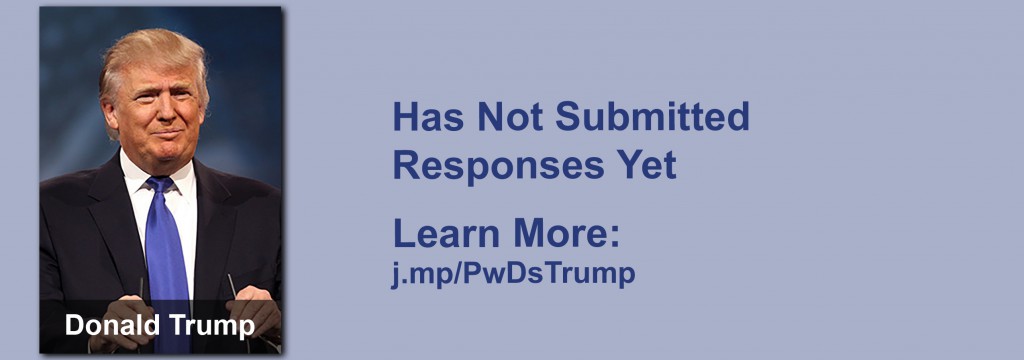Senate Candidates Have Yet to Complete #PwDsVote Disability Questionnaire
Washington, Oct. 13 – As voters get ready to head to the polls in New York, RespectAbility is releasing its New York Disability voter guide for the upcoming senate and presidential elections. Republican Wendy Long is challenging Democrat incumbent Chuck Schumer, who could be the next Senate Majority Leader if he should win and the Democrats gain control of the Senate, for the Senate seat. Unfortunately for 2,171,581 New Yorkers with a disability, neither have responded to the #PwDsVote Disability Campaign Questionnaire for Senate and Gubernatorial Candidates for people with disabilities. Twenty-three other candidates for Senate, as well as nine candidates for governor, from both sides of the aisle (19 Democrats, 13 Republicans) have responded so far, showing that disability rights is a nonpartisan issue. The responses also are geographically-diverse, coming from states all around the country, as politicians are paying more and more attention to the disability community. On the presidential level, Democrat Hillary Clinton has completed the questionnaire while Republican Donald Trump has yet to do so.
The #PwDsVote 2016 Campaign Questionnaires were designed by and for people with disabilities (PwDs) and those who love them to know where candidates stand on key disability issues. RespectAbility is nonpartisan and does not endorse candidates. The questionnaires are purely for educational purposes as voters go to the polls.
According to a new report from Rutgers University, 35.4 million people with disabilities will be eligible to vote in the November 2016 elections, representing close to one-sixth of the total electorate. That’s an increase of nearly 11 percent since 2008.
The presidential questionnaire was created during the primary season and asked all of the presidential candidates to comment on 16 disability questions. Former Secretary of State Hillary Clinton responded by addressing all of the questions. Despite numerous requests in person and by phone and email, the Trump campaign has not yet filled out the questionnaire. The American Association of People with Disabilities and the National Council on Independent Living also has a nonpartisan presidential questionnaire, which both Clinton and Trump have completed. Libertarian Gary Johnson and Green Party candidate Jill Stein have not filled out either questionnaire.
The down-ballot survey was adapted from the presidential questionnaire to ask gubernatorial candidates 16 questions and senatorial candidates 17 questions. All answers are posted verbatim and in full on The RespectAbility Report, a publication that covers the intersection of disability and politics.
Despite the Empire State’s abundant resources and vast population, the state varies in the employment rate of working-age people with and without disabilities. Currently, New York ranks 33rd in the nation in terms of jobs for people with disabilities and only 33.6 percent of working-age New Yorkers with disabilities are employed. Moreover, there is a 40.4-point gap between the labor force participation rate of New Yorkers with disabilities and those without disabilities. In order for outcomes to improve for people with disabilities, New York’s voters need to be informed on the candidates and where they stand on issues.
New York Needs to Improve Outcomes for Citizens with Disabilities
There are 1,106,507 New Yorkers with disabilities who are between the ages of 18-64. Additionally, there are 68,800 New Yorkers ages 16-20 with disabilities. More than 385,000 New York students have individual education plans (IEPs). However, many New Yorkers with disabilities have not yet received a disability diagnosis they need, and thus are not yet receiving the school accommodations and supports that they need to succeed. Many students who might need support to succeed academically instead find themselves trapped into a lifetime of poverty or flowing down the school to prison pipeline.
New York has the opportunity to work hard to improve outcomes in terms of competitive, integrated employment for people with disabilities. Currently 33.6 percent of working-age New Yorkers with disabilities are employed compared to 74 percent of those without disabilities. View the rankings of all 50 states and compare.
RespectAbility, founded in 2013, is a nonpartisan, nonprofit organization working to end stigmas and advance opportunities for people with disabilities. It has submitted comments for all 50 state’s drafts of the Unified Plan as required under Section 102 of the Workforce Innovation and Opportunity Act (WIOA). According to the written state plan, New York has some outstanding Project Search programs, but far too few of them to even scratch the surface of the need. It also has a model inclusive employer in IBM, yet has not provided enough STEM qualified people with disabilities to fill roles there and elsewhere.
One of the most important facets of WIOA is that it raises expectations for youth with disabilities and assists states to provide them with the supports they need to ensure success. Young New Yorkers with disabilities are an untapped resource that can be trained to bridge that gap. Indeed, a recent detailed study by the Kessler Foundation and the University of New Hampshire shows that 70 percent of working age people with disabilities are striving for work.
Evidence shows that people with disabilities can provide a wonderful solution to companies and other employers that want to succeed. The diverse skills, greater loyalty and higher retention rates of people with disabilities are already starting to meet employer talent needs in increasing numbers around America. With WIOA, New York can benefit from that progress if it truly breaks down silos within government agencies and partners, and lets innovation, based on evidence-based practices, take place. However, the gap in the labor force participation between people with and without disabilities is still too large around the entire country. This lack of employment for people with disabilities creates poverty, powerlessness, and poor health. Polls and studies show that people with disabilities want the opportunity to have the dignity and independence that jobs provide.
America has 1.2 million youth with disabilities, between the ages of 16 and 20. Each year 300,000 of them age into what should be the workforce, but stigmas and lack of knowledge about the capabilities of people with disabilities means that most do not find employers willing to hire them. Young adults with disabilities in all of these states are hoping to find work. They have high expectations and deserve the opportunity to achieve the American dream. Young people with disabilities may simply need some thoughtful help to transition into the workforce. See data on all 50 states here: State Data.
Fully one-out-of-five voters have a disability, and 52 percent of likely voters have a loved one with a disability. Only 34 percent of working-age Americans with disabilities nationally have jobs, despite the fact that the vast majority want to work. More than 11 million working age people with disabilities are now living on government benefits in our country.
RespectAbility President Jennifer Laszlo Mizrahi said, “Our community is looking for jobs so we can achieve the American dream, just like anyone else. It is vital for us to know where the candidates stand economic, stigma, education, safety, transportation, housing, healthcare, foreign affairs and other issues. The candidates have hugely different ideas about how to deal with the issues. Thus, it’s extremely important to read their full answers so you can understand their vast differences.”
Remember to Vote
New York residents can vote for the candidates of their choice either on the standard voting schedule or through absentee ballots. New Yorkers have until Oct. 14, 2016, to register to vote for the election. To register to vote, residents must fill out a voter registration form and send it to their county board of elections. Most information regarding registering can be found at: Register to Vote. Voters can also cast a vote through absentee ballots. In order to receive an absentee ballot, you must apply and have the ballot sent to the county elections board by Nov. 1. More information regarding absentee ballots can be found at: Absentee Voting.







Be First to Comment